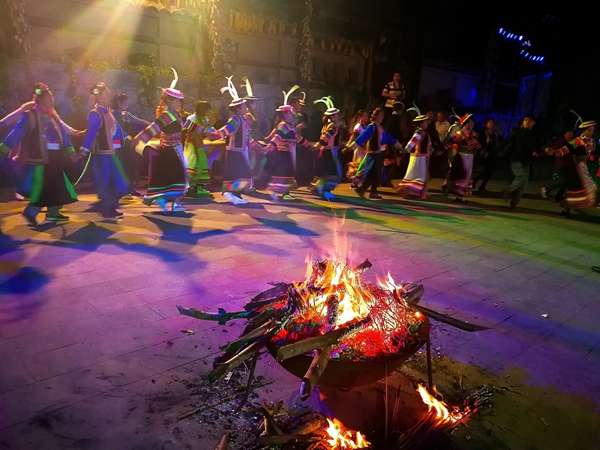Legends and origin of Baima Tibetans in Gansu
By taking advantage of its distinctive folk culture, the Baima Tibetan Township in Gansu province of northwestern China has developed itself into hot tourism spot. In 2017, the township has attracted 22 thousand tourists.
Known as “the most ancient tribe in East Asia”, the Baima Tibetans have preserved their ethnic culture and customs fairly well. Their masked dance named “Chigezhou,” is one of China’s intangible cultural heritages. The performance is vivid, bold, grand, and passionate.
The township has organized a folk culture performance troupe which rehearses at noon and in the evenings every weekend. Their performance has become a major attraction for tourists.

Baima Tibetans are dancing the fire ring dance.[Photo/www.CYOL.com]
The Baima Tibetans are one branch of the Tibetan people who live in Sichuan and Gansu Provinces, and have a population of about 14 thousand. “Baima” means “Tibetan soldier” in Tibetan and Baima Tibetans are said to be descendants of the Tubo Dynasty military.
Baima Tibetans like wearing felt hats decorated with white cock feather. There is a story behind. Long ago, when the Baima Tibetans were about to be attacked by their enemy one night, a white cock crowed to wake them up and saved them. In order to express gratitude, the Baima Tibetans have worn the feather for generations.
The Baima Tibetans have their own language, but no writing. According to Mo Chao, Vice President of Lanzhou City University, the Baima language is a independent language and the difference between Baima language and Tibetan is much more than the difference between different Tibetan dialects.
Your Comment
Name E-mailRelated News
-
;
-
-

-
Zhou Dance of Baima Tibetan tribe
The Baima twelve-mask dance, or the "Zhou dance" as known by the Tibetan Baima (white horse) tribe, is a mysterious dance dance on festive occasion or during rituals when sacrifices are offered to ancestors.
-
-
-
Baima Tibetan village benifits from developing western region
As a branch of the Tibetan ethnic group, the Baima Tibetans, known for the white plume on their hats, lived on herding, hunting and crop farming in the past.
-
-
-
Gansu Baima ethnic Tibetans welcome lunar New Year
Baima ethnic Tibetan is one branch of Tibetan ethnicity, mainly inhabiting Wen County of Gansu Province and Pingwu County of Sichuan province.
-
Based in Lhasa, Tibet Vista is a Tibet travel agency that specialized in Tibet permit, and Tibet tours for both private and group travelers at a local price!
•4 Days Lhasa City Group Tour from USD 460 •8 Days Everest Base Camp Group Tour from USD 850 •15 Days Mt.Kailash Group Tour from USD 1780 •2016 Tibet Train Tours from Beijing, Shanghai, Chengdu, Xining,etc










